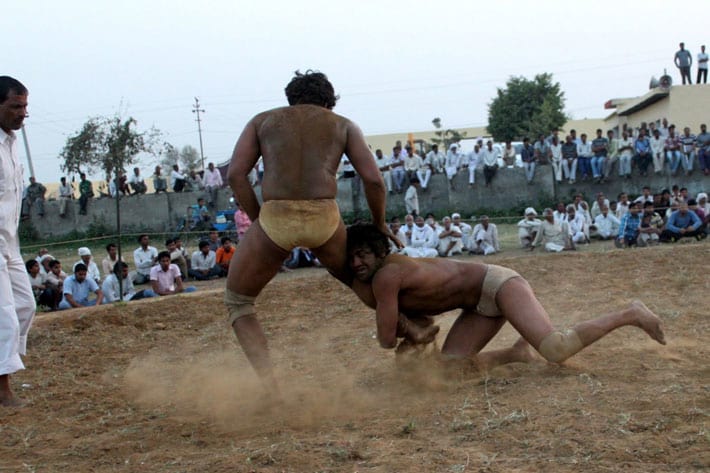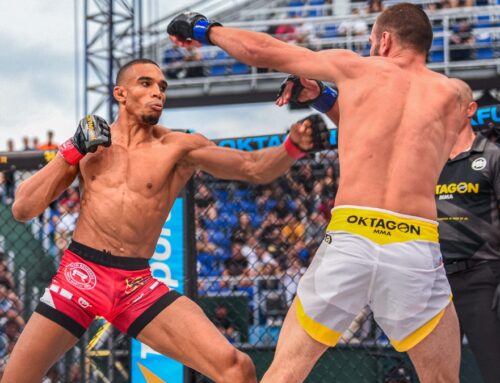There was a time when wrestlers were among the most revered members of Indian society. For over ten centuries, participants in the sport known in India as kushti were not athletes but aesthetes, walking a path of tradition and spirituality carved out by the thousands that had gone before them.
Wrestlers live together in domiciles called akharas. They are more like monasteries or temples than sports facilities. The wrestler’s every act, from eating and sleeping through to personal hygiene and personal relationships, is dictated by the culture and tradition of kushti. Purity is everything, so smoking, alcohol and sex are all prohibited.
Their commitment to an ascetic ideal meant that wrestlers assumed a kind of warrior-monk role in Hindu society. India is largely a Hindu society and the cow is a sacred animal; it is significant then that milk forms a key part of the wrestler’s traditional diet. Milk was not something available to the average person in ancient times, even in recent history.
The esteem with which wrestlers were held is illustrated by the story of the famous Indian pacifist revolutionary Gandhi encountering one on a train journey. People had come to meet Gandhi when the train had stopped and he was offered a bowl of milk, a significant gesture among Hindus. But when he learned that one of the assembly was a wrestler, Gandhi insisted that the milk be given to him instead.
In these modern days much of traditional Indian life has gone by the wayside, the same as it has in every other industrial country. Wrestlers and akharas still exist, kushti is still practiced, but they are vastly reduced in number and status, attracting reverence only from the elderly and the more conservative-minded of the population.
India is the world’s fastest-growing economy and its eyes are turned increasingly towards the future, the outside world and its new ideas and experiences. India’s youth – or at least, sections of it – have more money and better living standards than ever before and they are becoming a keenly-targeted nation of consumers. Advertisers are waking up to the increasing spending power of the previously insignificant rupee.
It is into this changing landscape that the fledgling Super Fight Leaguehas emerged. SFL is the first mixed martial arts event in India’s history and its founders – the high-profile celebrity pairing of Raj Kundra and Sanjay Dutt – believe that it has all the potential in the world to capture at least a decent share of the one billion people that make up the total Indian audience.
“In a country of more than a billion people it is not fair to have a fan following for just one game. Cricket will remain as the No. 1 game but Mixed Martial Arts is out to make a fan following of its own. The league is bound to attract youngsters between the age of 18 and 35,” says Dutt.
A logical proposition, but it will be interesting to see how MMA will be interpreted by Indian society as the SFL rolls on through 2012. As we saw earlier, wrestling has a long tradition in India and yet violence does not. The warrior Sikhs are a sizeable section of the populace but are vastly outnumbered by the Hindu population. Hinduism is a religion which is very much opposed to violence of any kind, and so one has to wonder if that will affect the reception of the SFL.
Perhaps it will make no difference. Perhaps, like Christianity in the west, Hinduism is something that large swathes of the population profess but only a small percentage actually follow to the letter. Christianity also eschews violence but the more devout Christian MMA fighters actually claim that their sporting activities are a way of praising god by using their bodies to the maximum of their potential. Perhaps the same could be said of fighters in a Hindu context?
There certainly doesn’t seem to have been any major controversy in the Indian press following SFL 1, but the mention of Gandhi in this article is not superfluous. There is in India a concept known as Gandhigiri, derived from the great man and referring to a general philosophy of peace and non-violence. At least one newspaper has asked SLF promoter Dutt about his supposed commitment to Gandhigiri clashing with his new promotion.
His response? “MMA inside the cage, Gandhigiri outside the cage.”
Perhaps that’s the enough – it is a sport after all – but what I’m curious about is how MMA is being pitched to the Indian audience in the long-term. Is SFL going to go the route that companies did in Russia when Communism collapsed, extolling the modern and thoroughly American virtues of the product they are selling as a way to capture the attention of a newly spendthrift youth, or will they have an eye to history and pitch the sport as being somehow rooted in the kushti tradition?
The overall decline of young men entering into akharas to pursue kushtisuggests that the former route may be more viable than the latter. Those young Indians with an interest in wrestling are increasingly tending to move into the freestyle and Greco-Roman forms; these provide routes into international competition, the Olympics and fame.
But I still think it would be an interesting idea – if it were actually possible – to try and get a kushti wrestler or two involved. As much as it pains me to admit it, storylines are as important in MMA as they are in pro-wrestling and the idea of an Indian wrestler emerging from his temple to defend his nation’s honour in the SLF arena against, say, an American or an Englishman, would surely resonate strongly with Indians as a whole.
For their next event, which takes place this Saturday, neither pacifism nor Hinduism will be of the slightest concern. That is because it is taking place in the city of Chandigarh, which is the capital of the Indian Punjab region. To say that region has a warlike history is an understatement. The Punjab’s story is one of invasion, revolution and war over thousands of years. Around 70 per cent of the population are Sikhs. They pride themselves on being a warrior people.
Traditionally, Sikh men carried a sword at all times. In the modern age, when carrying a sword into a restaurant or train carriage proved alarming for bystanders, Sikh males took to wearing a small gold sword as an item of jewellery, usually around the neck. The big swords have gone but the sentiment remains – these are not a people who turn their backs on a fight.
In fact the Punjab region has a reputation as being India’s most macho, culturally, and so the SLF has made a wise move in staging its second event there. If anyone in India is going to take to MMA it will be the young Sikh males, brought up on a fighting history and no stranger to impromptu fisticuffs themselves during one of the many, many traffic jams that characterise downtown Chandigarh.
There’s no information available on ticket sales for this weekend’s live event but it should do well there, for novelty value if nothing else. Its obviously very early to be making these kind of predictions but there’s enough about the local culture of Chandigarh to suggest that it could be India’s ‘fight town’ and a repeat stop on the SLF calendar.
Speaking of culture, another relatively new addition to the Indian entertainment world is the reality TV show. Perhaps because it is so populous and thus a difficult place to stand out as an individual, the Indian nation has embraced the reality show in a way few would have expected. They have a reputation as a somewhat conservative, reserved people but India’s reality TV experience suggests otherwise.
An MMA-centric reality show would probably do well on Indian television, again for the novelty value if nothing else. The UFC has been talking about an Indian TUF for a while now and everyone thought they were mad, but if you delve into the Indian press a bit you will see that reality TV stars enjoy considerable prominence. For an Indian to enter into TUF and emerge with a $100,000 contract for the world’s premier fighting organisation would be headline news. You can buy a lot of milk with that kind of money.
Of course, SFL might have its own plans for a reality show. If they do, the value of the contract will be less but I suspect the show would still be a runaway success in its first season simply because India will never have seen anything like it before. That, coupled with the celebrity presence that the two SFL promoters will be able to leverage, would make it compulsive viewing for the gossip-hungry middle-class Indian youth, exactly the audience SFL wants.
When I first heard about SFL, I thought it was doomed to quick failure. Now I am not so sure; they may be on to something. But with the UFC hovering in the wings with TUF and its global platform, SFL may already be fighting for second place in India’s MMA hierarchy without even knowing it. Can the cage become the new clay pit this year? We will find out soon enough.






